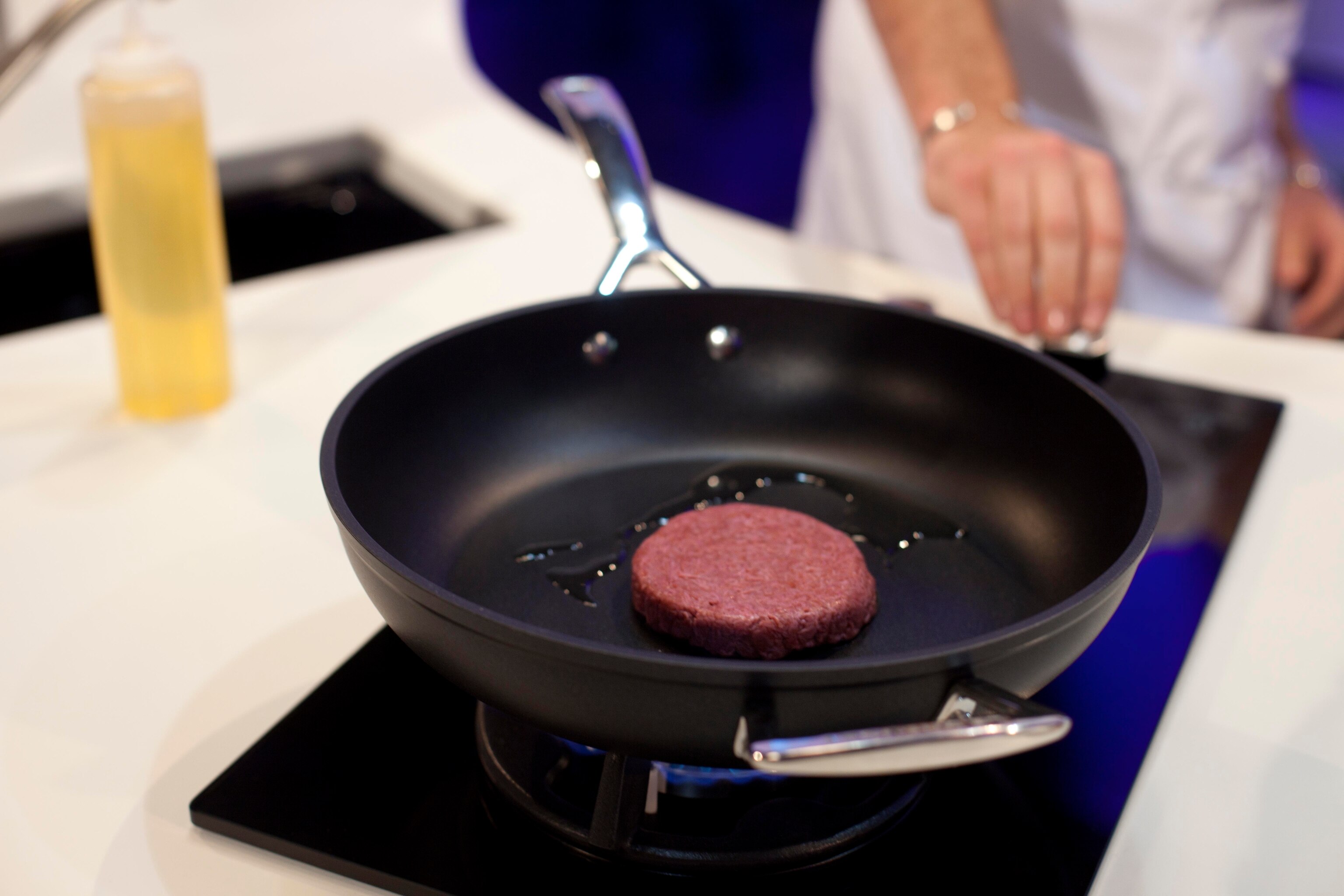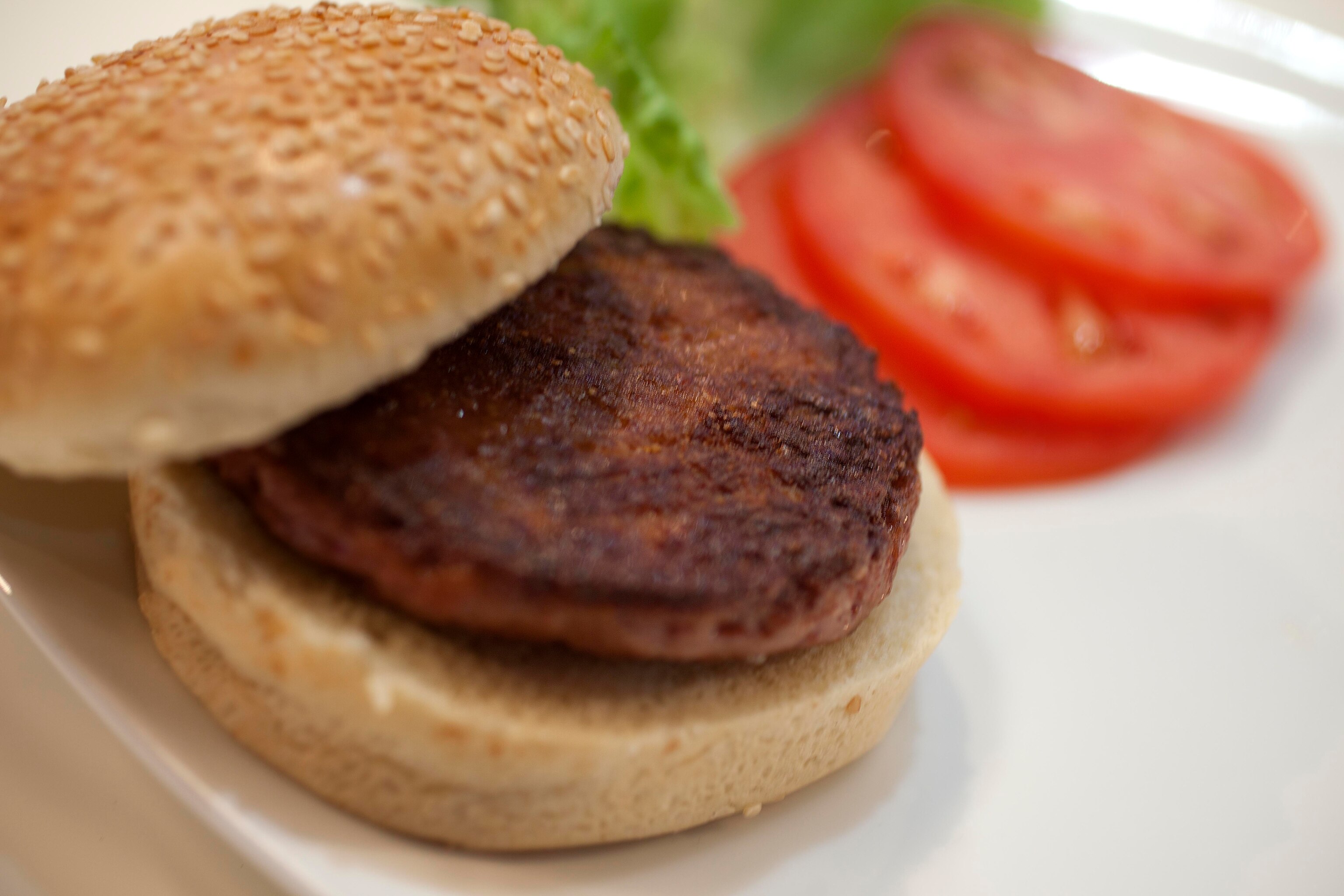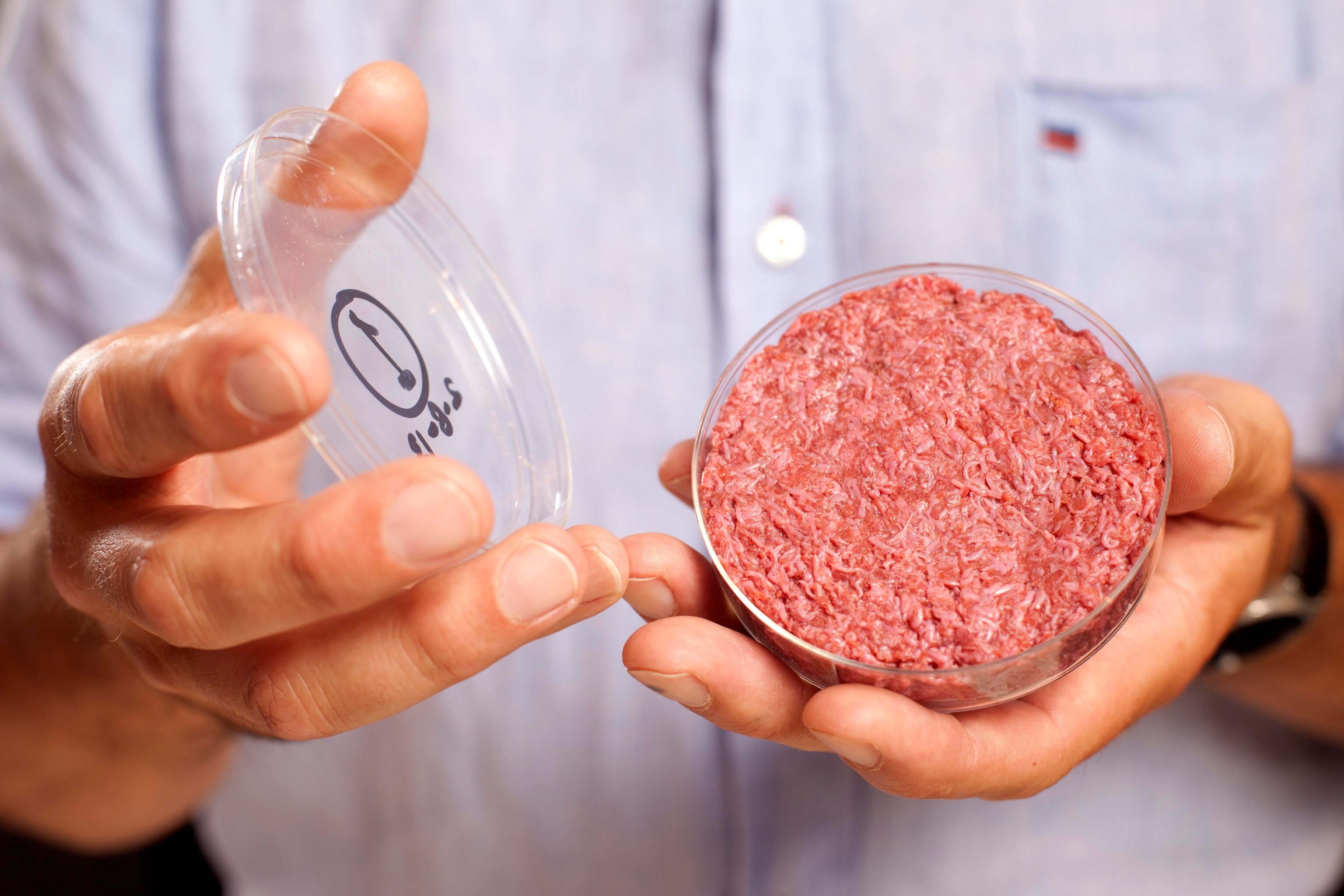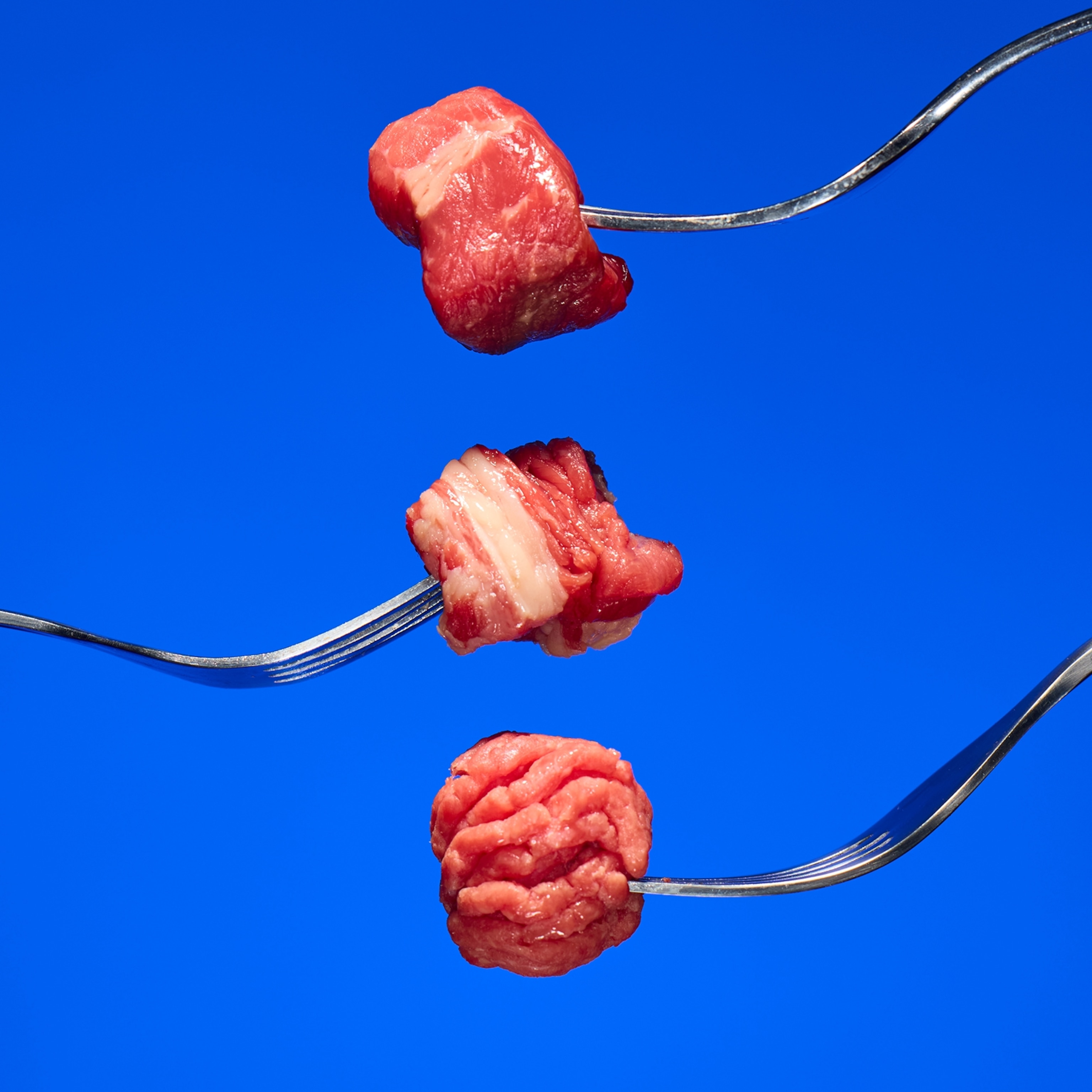Scientists nowadays can grow meat—well, at least, something sort of like meat—in the laboratory.
Lab-grown meat has been around at least since 2000, when the NSR/Touro Applied BioScience Research Consortium managed to produce edible fish filets from goldfish cells; and in 2001, NASA—in hopes of providing future astronauts with Thanksgiving dinner—began generating lab-grown meat from turkey cells.
Among the latest attempts was a much-publicized, high-tech hamburger, product of vascular physiologist Mark Post’s research lab at the University of Maastricht in the Netherlands. The five-ounce burger was made from bovine muscle stem cells, which had been bathed in a culture medium containing fetal calf serum to promote growth and differentiation. Once the stem cells had differentiated—that is, transmogrified themselves into genuine muscle cells—they were fed with nutrient solutions and tacked to a sugar scaffold on which they were “exercised” by applying tension—which, just like a course at the neighborhood gym, encouraged the growing muscle to bulk up.
The result was 20,000 tiny strips of cultured meat—a total of about 40 billion cow cells—that were assembled into a patty, sizzled in sunflower oil and butter, and handed over to a pair of expert tasters for an experimental munch: journalist Josh Schonwald, author of The Taste of Tomorrow: Dispatches from the Future of FoodThe Taste of Tomorrow: Dispatches from the Future of Food, and Hanni Rützler, an Austrian nutrition scientist and food researcher. Neither fell into raptures, which made it pretty clear that this stuff wasn’t exactly boeuf bourguignon, but the consensus was that it was…okay. It tasted meatish, both agreed, and was pleasantly crunchy. Researchers felt that this was a good start.

There’s a convincing case for substituting lab-grown meat for conventional meat in the human diet. Lab-grown meat—also known as cultured meat, in vitro meat, and (less attractively) shmeat, from “sheets of lab-grown meat”—has the potential to sharply reduce the number of animals raised and slaughtered in awful conditions on feedlots. Feedlots not only create unconscionable animal suffering, but threaten human health as well, disseminating pollution, contaminating groundwater reservoirs, and acting as breeding grounds for disease. Zoonotic diseases—that is, those that leap from animals to humans, such as avian and swine flus—are often the result of intensive feed-lot farming.
Unlike conventional meat, lab-grown meat is squeaky clean. It’s free of pesticide residues and far removed from the noxious gunk that litters slaughterhouse floors. And, though it is treated with antibiotics, amounts used are markedly less than in conventional meat production – where antibiotics are routinely administered to healthy animals, thus upping the chances of generating lethal antibiotic-resistant bacteria. According to the U.S. Food and Drug Administration, over 70% of antibiotics on the American market presently go not to human beings, but to pigs, cows, and chickens.
Lab-grown meat also has potential to be a plus for the environment. Collectively, worldwide, we consume 285 million tons of meat each year—a figure expected to double over the next decades. Because of our passion for pork chops, beefsteak, and bacon, about 30 percent of our planet’s arable land is dedicated to growing food for livestock—as opposed to a mere 4 percent dedicated to crops to feed people. Eighty percent of America’s corn crop and 95 percent of the nation’s oats go to animals. And those animals are massive contributors to deforestation, pollution, and greenhouse gases, to the tune of some 40 percent of global methane emissions. Various calculations suggest that lab-grown meat could reduce the need for land and water by 90 percent and overall energy use by 70 percent.
So—deprived of real meat—what about nutrition? After all, for a good two million years or more, we’ve been meat-eaters; and evolutionary biologist Richard Wrangham, in Catching Fire: How Cooking Made Us Human, argues that our ability to broil, roast, and barbecue may have led to our present-day bigger brains. Can cultured meat be a viable substitute for—say—a haunch of braised mammoth?

Unlike conventional meat, lab-grown meat is pure protein—there’s no fat, blood, or connective tissue which is where much of the taste and texture of meat comes from. Researchers plan eventually to add fat cells to their final cultured products—but, unlike in conventional meat, there’s a chance for beneficial tweaking here. For example, in lieu of meat’s saturated fats—implicated in cardiovascular disease and diabetes—lab-grown meats could substitute the far-better-for-us omega-3 fats.
The negatives?
Not everybody likes the thought of test-tube meat. Some people simply find the whole idea icky. Detractors point out that lab-grown meat is not as cruelty-free as it’s cracked up to be: those starter stem cells, for example, still come from animals; and the fetal calf serum commonly used in cell culture comes from slaughtered pregnant cows. Others argue that—rather than waste time and energy on developing lab-grown meat—it makes more sense to drop meat-based diets altogether, in favor of more sustainable and environmentally friendly vegetarian and vegan meals. One source calculates that—while it takes three acres of land to feed a single human meat-eater—a vegan can get by just fine on a mere sixth of an acre.
In any case, lab-grown meat won’t be showing up on supermarket shelves anytime soon. Researchers predict that it won’t be available for another 10 to 20 years.
By which time, hopefully, the price will have come down.
Post’s five-ounce lab-grown burger came with a price tag of $325,000.
References:
- Bland, Alastair. Is the Livestock Industry Destroying the Planet? Smithsonian, August, 2012.
- Specter, Michael. Test-Tube Burgers. The New Yorker, May 23, 2011.
- Zareska, Marta. Is Lab-Grown Meat Good for Us? The Atlantic, August 2013.







